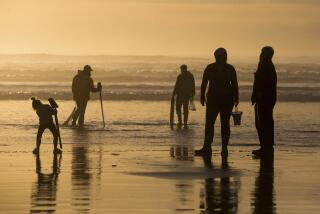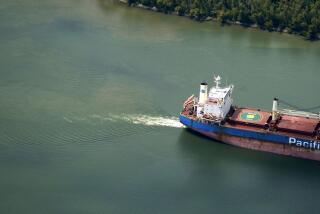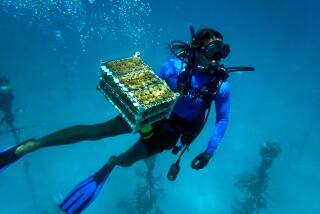Crabbers Claw for Survival
DARIEN, Ga. — As Carl “Poppa” Poppell zooms his boat around the North River, shrimp skip in his wake like water skiers and the wind flattens his cap against his tanned forehead. “Going NASCAR,” the crabber, 50, calls it.
Then something stops him cold. Tangled in the cordgrass off the starboard side is a pink-and-white buoy with the initials “C.P.” marking one of his crab traps.
“See that clean cut?” he said as he ran his calloused hand across the shorn rope. “That’s a knife or a machete or a hatchet.... Props don’t do that.”
Poppell has lost 60 crab pots to vandalism this summer, some of the 600 cut during a turf war in the marshlands south of Savannah. That’s what competition and frustration have driven some of these blue crab fishermen to.
In many ways, the crabbers have become like their prey, scratching and clawing for survival in an ecosystem that is quickly becoming less hospitable to them. Last year’s Georgia blue crab catch was a historically low 2.7 million pounds, less than a third of the 46-year average, and it’s worse elsewhere in the Southeast.
Now, a young ecologist is saying that without the crabs, the marshes themselves might die -- the very marshes that serve not only as the crabs’ nursery but as a breeding and feeding ground for shrimp, drum, oysters and other commercially important species. In some areas, the researcher suggests, overfishing of the crabs may be a major culprit.
No, no, no, Poppell says. Development, drought and other factors upstream are starving the estuaries of fresh water, raising their salinity, breeding disease. That’s what got him where he is today, he says -- not overfishing. But with things as they are, he worries that he may be overfishing what’s left without even meaning to.
As he motors through the creeks, Poppell wonders whether he and the crabs are racing toward the same bleak future.
*
Hundreds of miles of Southern spartina, or cordgrass, marsh have died in recent years from the Chesapeake Bay to the Gulf coasts of Florida and Louisiana. Ecologist Brian Silliman says some are dying at a snail’s pace -- and that’s what scares him.
For the last half a century, a basic assumption of salt marsh ecology was that the forces regulating spartina grass growth and health were generally “bottom-up” -- nutrient levels, water salinity, oxygen conditions. But Silliman surveyed several of those dead and dying marshes and found very high densities of periwinkle snails.
Blue crabs are one of the snail’s most important predators, and crab populations have been in rapid decline. In the Chesapeake, researchers have documented an 81% decline in spawning stock since 1992.
Silliman set out to see if the two phenomena were connected.
Researchers have long known that the periwinkle feed off dead or dying spartina. But the 29-year-old Brown University doctoral student noticed something -- without blue crabs, the snails were going after the healthy, live grass.
Testing his theory on Georgia’s Sapelo Island, Silliman found that the inch-long snails graze the grass to cause scars that then become infected by fungi. That’s what the snails are really after, and they’re literally farming the grass to get it.
Slogging through black mud that sucks the boots off their feet with every step, Silliman and Mark Bertness, his professor, peppered Sapelo with meter-square wire cages, excluding blue crabs from test plots to see what the snails would do.
The result: Within eight months, the snails had changed one of the world’s most productive grasslands into a barren mud flat.
“They just mow it down,” Silliman said, standing between two cages -- one with tall, healthy green grass, the other a dead zone.
What Silliman found were signs of a classic “trophic cascade,” a process in which the removal or compromise of one key species starts a chain reaction that results in a total system collapse. Bertness compares it to the destruction of California’s kelp beds around the beginning of the 20th century, when otter overharvesting led to rampant sea urchin overgrazing.
Rom Lipcius, a crab specialist at the Virginia Institute of Marine Science, says Silliman’s research is both fascinating and timely as scientists and regulators grapple with man’s influence on nature -- and his attempts to set things right.
In the Chesapeake, for instance, much effort has been put into restoring the oyster beds that are as synonymous with the bay as lobster is to Maine. Now researchers are considering whether increasing stocks of blue crabs, the oysters’ main predator, will preclude that restoration.
Crabbers, in turn, are worried that the success of efforts to restore the bay’s striped bass fishery have cut into their business. Lipcius has heard reports of bass being caught with 100 juvenile blue crabs in their stomachs.
“You sort of get into all these vicious cycles,” he said. “We might not be able to fix it because we’ve changed so many other parts of the system as well that it’s just not able to adjust.”
*
“Overharvesting of blue crabs may be triggering the colossal die-off of salt marshes across the southeastern United States.”
That was the headline on a Brown University release about Silliman’s work.
For Poppell, it was like a red flag to a cornered bull. He wanted to meet this Silliman guy. Probably another one of those eggheads who sits behind a desk all day trying to find ways to hurt working folk.
“We’ve lived this thing,” Poppell said as he pointed his boat toward Sapelo. “We may not have all the scientific data to back it up, but we’ve lived it.”
Silliman meets the boat at the ferry dock. His white boots and green Army pants are splattered with marsh mud. At least he’s not afraid to go out and get dirty for his information, Poppell figures.
The young ecologist assures Poppell that, headlines aside, his study was only meant to flash a “yellow light of caution” to crabbers and those who regulate them. Poppell has already seen the light.
When things started going south, he and other Georgia crabbers went to state officials and offered to limit themselves. They went from unlimited licenses and unlimited pots to 159 crab permits, each allowing its holder 200 traps -- and not all have been taken.
Doug Haymans, the Georgia Department of Natural Resources’ liaison to crabbers, agrees with Poppell that disease, drought and other factors, not overfishing, are likely the problem here. But to Silliman, the result is the same -- no crabs could mean no marsh.
Silliman is testing his theories in other places. He recently set up cages in the bayous south of Baton Rouge, where up to 35 miles of marsh are being lost each year in an ecosystem that supports up to 25% of the nation’s coastal fisheries.
Silliman knows that snails are probably not causing the die-offs there. But they are probably contributing to and benefiting from them.
What he does know is that the crabs and marshes are linked in ways that no one knew before. And so are the crabbers, shrimpers and others who depend on these resources.
*
Back on the North River, Poppell speeds from float to float, pulling traps to the surface and dumping them. Trap after empty trap comes up caked with growth, its bait well still full of rotting mullet.
For most of the morning, he lands more flounder, spadefish, hermit crabs and puffer fish than he does blues. This stretch of water was his “honey hole” for 25 years, averaging up to 1,500 pounds a day in this part of the season.
“I can’t even make a living out of it now,” he said ruefully.
Next, Poppell heads into another river that was recently abandoned by a fellow crabber who moved on to greener pastures. Because of the competition, he doesn’t want it named or even described.
There, he hauls in traps with 10, 15, 20 crabs apiece -- better, but still a third of what they should be, or worse.
Close to quitting time, another boat rounds a horseshoe bend in the marsh and pulls alongside Poppell’s. It’s Carl Jr.
“I might have a box,” the 25-year-old son said over the idling motors. “This time of year, we should be catching eight, 10 boxes apiece, easy.... After I take out my bait, my gas, I might make 30 bucks. This is a very poor day. Very poor.”
Together, father and son have landed about two boxes of crabs.
As he heads in for the day, Poppell is feeling as endangered as the wood stork gliding overhead. But in the bow of his boat is one small consolation -- tangled in a float line was one of his severed pots.
Call it a $25 payback.
“That was my catch of the day,” he said with a wry smile.
And there was another bonus. Inside was a single blue crab.
More to Read
Sign up for Essential California
The most important California stories and recommendations in your inbox every morning.
You may occasionally receive promotional content from the Los Angeles Times.










